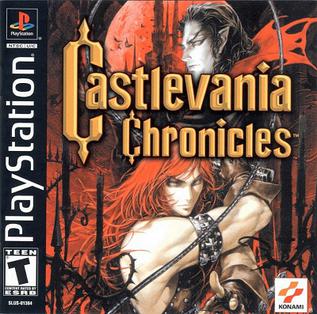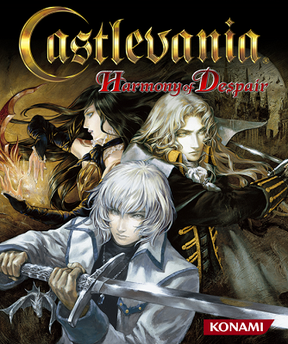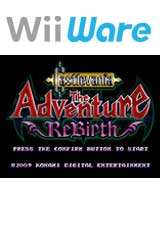
Castlevania, known in Japan as Akumajō Dracula, is a gothic horror action-adventure video game series and media franchise about Dracula, created and developed by Konami. It has been released on various platforms, from early systems to modern consoles, as well as handheld devices such as mobile phones. The franchise has expanded into several spin-off video games and other media, including comic books and an animated television series.

Castlevania: Symphony of the Night is a 1997 action role-playing game developed and published by Konami for the PlayStation and Sega Saturn. It was directed and produced by Toru Hagihara, with Koji Igarashi acting as assistant director. It is a direct sequel to Castlevania: Rondo of Blood, taking place four years later. It features Dracula's dhampir son Alucard as the protagonist, rising from his slumber to explore Dracula's castle which resurfaced after Richter Belmont vanished. Its design marks a break from previous entries in the series, re-introducing the exploration, nonlinear level design, and role-playing elements first experimented with in Castlevania II: Simon's Quest.

Castlevania: Rondo of Blood, originally released in Japan as Akumajō Dracula X: Chi no Rondo, is a 1993 platform game developed by Konami for the PC Engine's Super CD-ROM² System directed by Toru Hagihara. Part of the Castlevania series, protagonist Richter Belmont goes to save his lover Annette, who was abducted by Dracula. It was first released exclusively in Japan on October 29, 1993. A direct sequel, Castlevania: Symphony of the Night, was released worldwide in 1997.

Castlevania II: Simon's Quest is a 1987 action role-playing game developed and published by Konami. It was originally released in Japan in 1987 for the Famicom Disk System, and in North America in 1988 for the Nintendo Entertainment System. It is the second Castlevania game released for the NES, following the original Castlevania (1986). Set seven years after the events of the first installment, the player once again assumes the role of vampire hunter Simon Belmont, who is on a journey to undo a curse placed on him by Dracula at the end of their previous encounter. Dracula's body was split into five parts, which Simon must find and bring to the ruins of Castle Dracula in order to defeat him. The game deviates from the traditional platforming of its predecessor, incorporating role-playing and open world elements.

Castlevania: Circle of the Moon, titled Castlevania in PAL regions, is a 2001 action role-playing game created by Konami for the Game Boy Advance. Published as a launch title in 2001, Circle of the Moon is part of Konami's Castlevania video game series, the premise of which centers on the eternal conflict between the vampire hunters of the Belmont clan and the vampire Dracula. The game sold one million copies worldwide and was acclaimed by critics. The events of its plot were retconned by former Castlevania producer Koji Igarashi, a move which was met with some criticism.

Castlevania: Harmony of Dissonance is a 2002 action role-playing game developed by Konami Computer Entertainment Tokyo and published by Konami for the Game Boy Advance. Part of Konami's Castlevania video game series, it is the second installment of the series on the Game Boy Advance. It was released in Japan in June 2002, in North America in September 2002, and in Europe in October 2002.

Castlevania III: Dracula's Curse is 1989 platform game developed and published by Konami for the Nintendo Entertainment System. It is the third installment in the Castlevania video game series and a prequel to the original Castlevania. The game follows Trevor C. Belmont, an ancestor of Simon Belmont, as he gathers allies and travels the country of Wallachia on a quest to defeat Dracula.

Castlevania: Curse of Darkness is a 2005 action-adventure game developed and published by Konami. It is the fourth 3D Castlevania title, following Castlevania: Lament of Innocence, and was released for PlayStation 2 and Xbox in all regions except Japan, where the game was only available on PlayStation 2. Curse of Darkness received mixed reviews, common praise was directed towards its combat system, music, content, and replay value, while criticism fell towards its story, characters, repetitive level-design and gameplay.

Castlevania Legends is a 1997 platform game developed and released by Konami for the Game Boy. The third Castlevania game released for the system, the story follows Sonia Belmont, a vampire hunter battling the first incarnation of Count Dracula. The game was conceived as a prequel to all other games in the Castlevania series; however, it later became recognized as non-canon.

Castlevania: The Adventure is a 1989 platform game developed and released by Konami for the Game Boy. It is the first Castlevania title for the system. Castlevania: The Adventure was re-released in color as part of the Konami GB Collection compilations in Japan and Europe. A remake titled Castlevania: The Adventure ReBirth was released as a WiiWare game for the Wii. The original game is included in the Castlevania Anniversary Collection, which was released in 2019.

Super Castlevania IV is a 1991 platform game developed and published by Konami for the Super Nintendo Entertainment System. It has been re-released multiple times, including for the Super NES Classic Edition.

Castlevania II: Belmont's Revenge is a 1991 platform game developed and published by Konami for the Game Boy. It is the second Castlevania title for the Game Boy and serves as a sequel to the previous title, Castlevania: The Adventure. Belmont's Revenge is included in color in the fourth volume of the Konami GB Collection compilations. Set fifteen years after the events of Castlevania: The Adventure, Dracula returns and kidnaps Christopher Belmont's son Soleil at his coming of age feast, and turns him into a demon. With Soleil's mystical powers, Dracula retakes human form and rebuilds his castle, forcing Christopher to confront Dracula once again to save his son and Transylvania.

Castlevania: Bloodlines, known in Japan as Vampire Killer and in PAL regions as Castlevania: The New Generation, is a 1994 platform game developed and published by Konami for the Sega Genesis as part of the Castlevania series. A vampire named Elizabeth Bartley is orchestrating the beginning of World War I as a sacrificial war to bring her uncle, Dracula, back to life. Players take on the role of Quincey Morris' son, John, and his friend Eric Lecarde to take up the fight against evil.

Castlevania Chronicles is a platform game compilation developed by Konami Computer Entertainment Tokyo for the PlayStation. It consists of two game modes: Original Mode, which is a port of the 1993 platform video game Akumajō Dracula for the X68000 home computer, and Arrange Mode, a modernized remake featuring a new introductory cinematic, new sprites, and re-balanced gameplay among other adjustments. The X68000 version of Akumajō Dracula is, itself, an updated remake of the original Castlevania for the NES, where the vampire hunter Simon Belmont must defeat Dracula and save Transylvania. The compilation was later released for the American and Japanese PlayStation Network as a PSone Classic in December 2008.

Castlevania: Order of Ecclesia is a 2008 action role-playing game and the third Nintendo DS installment of the Castlevania franchise. Directed by Akihiro Minakata, with producer Koji Igarashi returning. The plot involves Shanoa, who is part of an organization set to defeat Dracula after the Belmont clan has vanished.

Castlevania Judgment is a 3D fighting video game developed by Eighting and published by Konami for the Wii. The game is based on the Castlevania series of games, and is the series' first fighting game.

Contra ReBirth is a 2D run and gun video game developed by M2 and published by Konami for WiiWare. It is the twelfth original installment in the Contra series. It was released in Japan on May 12, 2009, the PAL region on September 4, 2009, and North America on September 7, 2009.

Castlevania: Harmony of Despair is a multiplayer-focused platform-adventure game in the Castlevania series, featuring an ensemble cast of characters from the 2-D Metroidvania era of games, developed and published by Konami for Xbox 360 in August 2010, and for PlayStation 3 in 2011.

Castlevania, known in Japan as Akumajō Dracula, is a 1986 platform game developed and published by Konami for the Family Computer Disk System. It was originally released in Japan in September 1986, before being ported to cartridge format and released in North America for the Nintendo Entertainment System (NES) in May 1987 and in Europe in 1988. It was also re-issued for the Family Computer in cartridge format in 1993. It is the first game in Konami's Castlevania video game series.




















